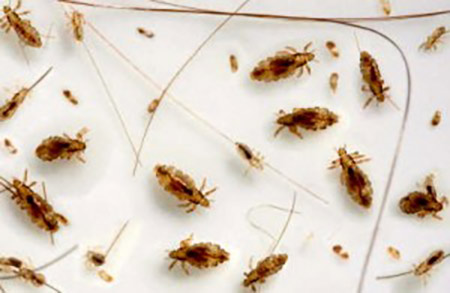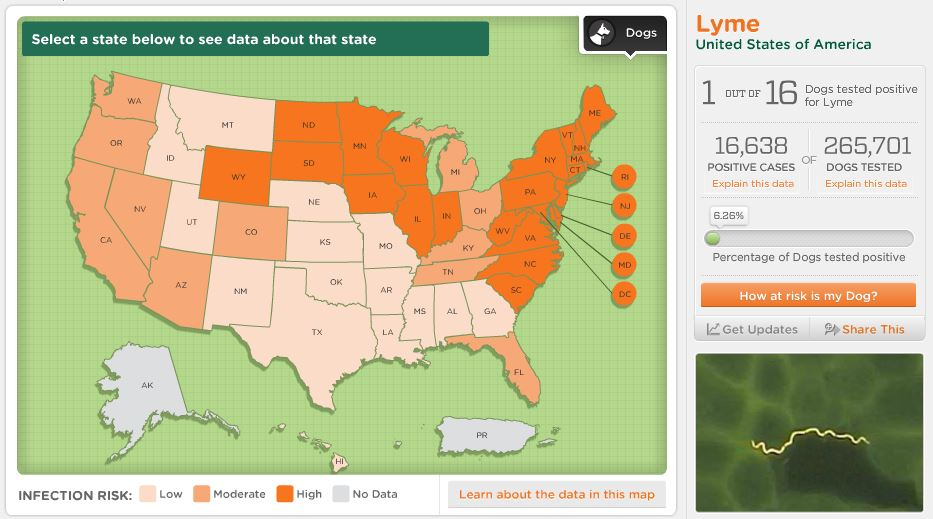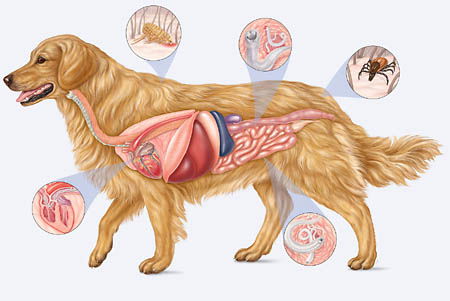
Parasites in dogs take many forms, but they all have one thing in common: sooner or later their presence will almost always have an impact on your pet's health or comfort. They can cause anything from mild irritation to serious illness. To cover all of the parasites in detail would (and does) take up a book. So here is an overview of the most common parasites, how they work, and the problems they may cause.
First, let’s define what a parasite is. It’s actually pretty simple. The Centers for Disease Control and Prevention sums it up:
“A parasite is an organism that lives on or in a host organism and gets its food from or at the expense of its host.”
According to the Companion Animal Parasite Council (CAPC), many dogs will be infected with parasites at some point in their life.
Types of Dog Parasites
Internal
- Heartworm
Intestinal
- Hookworms
- Ringworms
- Roundworms
- Tapeworms
- Whipworms
- Coccidia, Giardia, and Spirochetes (non-worm parasites)
External
- Fleas
- Ticks
- Lice
- Mites
Internal Dog Parasites
Heartworms enter a dog's bloodstream from the bite of an infected mosquito. The worms mature in the dog's heart (they can grow up to an amazing one foot in length), and clog it. Inflammation in the dog’s arterial wall disrupts blood flow, making the heart have to work harder. Once blood flow slows sufficiently, a heartworm-infested dog develops a mild, persistent cough, may become fatigued after only mild exercise, and suffers from a reduced appetite. The end result can be heart failure.
Though veterinarians look for these typical signs, most dogs harboring this parasite do not have clinical symptoms prior to the worms being detected via screening tests. These tests are usually done during routine veterinary check-ups. The test is so sensitive that it can detect a single worm in a dog's body. However, it can only detect the presence of adult heartworms, so timing is very important. There are other tests to determine the presence of heartworms, and your vet can walk you through them.
Three simultaneous factors are necessary for heartworm to become a threat to your dog:
- other infested dogs
- mosquitoes to carry the parasite
- the right temperature
Treatment for heartworm is expensive and hard on the dog, and must be administered by a veterinarian. In rare cases, surgery will be required to remove them. Luckily, there are many effective options for heartworm prevention. These include daily and monthly tablets and chewables, and monthly topicals.
Note that Collies and certain other herding breeds have a sensitivity to heartworm preventives that is genetically- based, and which your vet can test for.
Here is more in-depth information about heartworms.
Intestinal Dog Parasites
Hookworms live inside a dog's digestive system, and are acquired either by puppies from their mother (when nursing) or by adult dogs swallowing the parasite's eggs, or having the hookworm burrow into the skin. Hookworm larvae live in soil, and can be ingested when the dog comes in contact via eating them or through routine self-cleaning. After attaching to the lining of the intestinal wall, the hookworm feeds on the dog's blood. The resulting blood loss can have serious effects, especially on puppies. Your veterinarian can detect hookworms by examining a stool sample under a microscope. Infection can be prevented by keeping your dog's environment clean.
As with a number of intestinal parasites in dogs, diarrhea and weight loss are common symptoms of infection.
Ringworm is actually a fungus, not a worm. Because of their still-developing immune system, puppies less than a year old are more susceptible to ringworm. Adult dogs who are malnourished or stressed, or whose immune system is diminished, are also at risk, and the ringworm fungus is easily transmitted. An infected dog will develop lesions on his head, ears, paws, and forelimbs. The lesions cause circular bald spots which sometimes look red in the center. In mild cases, a dog might suffer only a few broken hairs. In severe cases, the infection can spread over most of the dog’s body.
Treatment depends on the severity of the infection. Veterinarians typically prescribe a medicated shampoo or ointment to kill the fungus in mild cases. Severe cases may need oral medications, in addition to clipping the fur.
Roundworms are an extremely common parasite, and again, puppies are most at risk. They look like white, firm, rounded strips of spaghetti, one to three inches long. Your veterinarian will look for signs of roundworms in the stool sample. Some of the symptoms of roundworm are coughing, vomiting, diarrhea, or malnourishment. Roundworms can infect other dogs and children.
Here is more in-depth information about roundworms.

Tapeworms are ingested by your dog, via a host that is harboring a tapeworm egg. This is usually an adult flea. It will cause your dog to lose weight and have occasional diarrhea. You'll know if your dog's got them because you'll see segments of the worms around his anus or in his stool. The segments look like grains of rice. Your veterinarian will administer medication by injection or orally. The medication is highly effective. The best protection against tapeworms is to the keep your dog free of fleas and away from dead animals and garbage.
Here is more in-depth information about tapeworms.
Whipworms are acquired by licking or sniffing contaminated ground. An adult whipworm is only about 1/3-inch long, and resembles a very small piece of thread. They live in the dog's large intestine, but unlike other parasitic worms they are very difficult to spot in a stool sample. A telltale sign, though, is a stool that has a mucous covering, usually at the tip. Weight loss is the chief symptom of a whipworm infestation. Though whipworms are rarely a cause of death, an afflicted dog will need to be treated with a dewormer.
Coccidia, Giardia, and Spirochetes are invasive, non-worm parasites that live in a dog's intestinal tract. What makes them particularly dangerous is that they can infect a dog before he actually appears sick. It may not be clear that the dog is carrying these parasites until stress or another immunity-compromising factor arises. Coccidia are single-celled and found more frequently in puppies, where they may acquire it through their litter mates or mother. Older dogs and cats may also be susceptible. Spirochetes can live in the bloodstream, as well as in the intestine, and can cause Lyme disease, syphilis, and other serious diseases. Giardia are found throughout the U.S. and are, unfortunately, a pervasive protozoa. Transmission of these parasites can come from infected soil, water, feces, food, other animals, and more. As with all parasites, diligent sanitation practices are important to stave off these parasites.
External Dog Parasites
Fleas are tiny wingless insects that feed on mammals, including dogs. Fleabites make some dogs so miserable that they bite and scratch themselves raw. Other dogs do not seem to respond to fleabites with the same intensity. If you see evidence of fleas on your dog, it is essential to get rid of them as quickly as possible, before the population grows. Hungry fleas sometimes bite humans too, leaving small, red, itchy bumps most commonly observed on the wrists and ankles.
You may be able to see the dark fleas, about the size of sesame seeds, scurrying around on the skin. Their favorite spots include the base of the ears and the rump. Look closely to sparsely haired places, like the groin, for telltale signs. A more accurate way to diagnose fleas, however, when live ones aren't observed, is to part the fur in several places and look for tiny black specks about the size of poppy seeds. These specks are flea feces, composed of digested blood. If you're not sure whether you're looking at “flea dirt” or just plain dirt, place it on a damp piece of white tissue. After a minute or so, a small red spot or halo will become apparent if it's flea feces, since the blood re-hydrates and diffuses into the tissue.

An adult flea and larvae
Here is more in-depth information about fleas.
Ticks can cause a number of serious illnesses, and canine tick-borne diseases include Lyme disease, Ehrlichiosis, and Rocky Mountain Spotted Fever. There are over 800 species of ticks worldwide and they all feed on the blood of mammals, birds, and reptiles. Ticks go through four life stages. Given the many ailments associated with ticks, annual screening by your vet for tick disease is mandatory. There are broad-spectrum antibiotics that are effective for tick-borne diseases.
Check your dog for ticks daily if he spends any time outside, and whenever you see one, take it off immediately. The best way to do this is to numb the tick with rubbing alcohol or petroleum jelly, then pull it off with tweezers. Once removed, kill the tick by putting it in a container of alcohol. Prevent an infestation by treating your dog with a medication, dip, spray, or powder as recommended by your veterinarian.

A few of the most common tick species
Here is more in-depth information about ticks.
Lice and mites are microscopic organisms that feed on your dog's skin and cause itching, hair loss, and infection. Generally speaking, lice and mites are two different species, but they function and behave in a very similar way. Lice live in a dog's hair and can be killed with an insecticide used for ticks or fleas. Various kinds of mites inhabit different areas of the dog, and the problems they cause are generally known as mange. Demodectic mange causes hair loss around the forehead, eyes, muzzle, and forepaws. Note that dog lice and human lice are different species—dog lice need dog blood and human lice need human blood. While humans may occasionally be bitten by dog lice, they will not get an infestation. Your dog may have mites if he shakes his head and scratches his ears. Scabies, which affects humans as well as dogs, is caused when mites burrow into the dog's skin. Scabies usually affects the ears, elbows, legs, and face. There is also a mite that causes “walking dandruff” on a dog's head, back, and neck. This mite also causes itchy red spots on humans. All mites should be diagnosed by a skin scraping by a veterinarian.

Dog Parasites by Region
The CAPC website has very helpful prevalence maps that provide data of the infection of parasites, from low to moderate to high, across the U.S., broken down by state. Especially useful is that the maps are further broken down into types of parasite, the risk to your pet. There are also separate maps for cats, and there is a glossary of additional parasites and terms.


Courtesy Companion Animal Parasite Council
How to Prevent Dog Parasites
To avoid parasite problems before they start, think of these three “M”s:
- Medicate with preventives. Yes, there are effective treatment options for once your dog is infested—some are simple and others more complicated. But with the wide availability of extremely effective preventive medications, you can help ensure that your buddy is not plagued with squirming, burrowing, or biting pests. For internal, intestinal, and external parasite preventives, ask your vet for her recommendations for the particular needs of your dog.
- Monitor your pet with annual screening tests from your veterinarian. You should also watch for changes in your dog. If he is behaving differently, or there are changes in his appetite or how much water he is drinking, these may alert you to a potential problem.
- Maintain a clean environment for your dog. Make sure bedding, food and water dishes, coats, etc., are cleaned regularly. Keep him away from garbage, dead animals, and other dogs or cats who may be infected. Remove feces at least once a week from wherever your dog eliminates.
Sources: American Veterinary Medical Association (AVMA); Companion Animal Parasite Council (CAPC); Heartworm Society; Merck Veterinary Manual; Pet Education; PetMD
